Sunday, August 16, 2009
Back to School This Week
As I look at going back to school this week, I am forced to ponder all of the things I did and didn't accomplish this summer. I guess the biggest frustration is not finishing one of the novels that I set out to complete or finish the typing on some other works. I have been writing a lot as of late and actually have quite a bit done on a novel I hadn't planned to start until the fall. I have come to realize that the key for me is to have a routine and carved out times to write. During the summer, I had so much free time that I didn't focus my energies on my writing. It seems that when I get back into the teacher mode and have less time, I am more focused and get a lot more done. I also think I am inspired more by talking about writing with my students and studying some of the great pieces of literature. So, I am excited about the new school year, working with new students, and getting my writing back on track.
Saturday, August 15, 2009
Jubilee Days
Today is our town's celebration called Jubilee Days. This will be the first time we've been able to go in a couple of years, because we are usually out with my wife's family for the weekend. We had that weekend last week, so we will be able to share in the communities celebration. It's always good to get out and talk with friends and just say, "Hi," to those we haven't seen over the summer. Who know how many story ideas are lurking around the corner?
Friday, August 14, 2009
Reflection on our History Trip to the Greenville, Ohio Area
As a writer, everything become grist for the mill. You pour as much knowledge as you can into your head so you can use that knowledge to make your writing better. To write historical pieces, you need to see it , experience it, and see the interlocked connections of culture, environment, and history. There are stories on every corner, and when you are learning about the past, or experiencing new places, you have added to that great filing cabinet in your head. As I’ve said before, you need to take advantage of the historical places around you and learn as much as possible. Use that knowledge to create more in-depth works. I hope you’ve enjoyed reading about my trip into Greenville, Ohio. It’s a time the kids and I will not soon forget and hopefully, it will encourage you to get out and expand your knowledge.
Thursday, August 13, 2009
Early Days in Western Ohio

I’ve spent a lot of time talking about all of the sights we visited, but there’s one more thing I want to say about the Garst Museum. The museum also took the history back to ice age times. There was even the fossils of a mastedon. I had Kaleb pose by them just to show how big the mastedon’s jaw was.
The following is from a pamphlet provided by the museum:
The first people here were nomadic hunters called Paleo-Indians who left flint spear points and tools. Glaciers receded and the climate warmed as people of the Archaic Tradition settled more, cultivated plants, ground seeds and invented the atlatl. Glacial Kame Indians had complex funeral ceremonies and more extensive trade.
I know there have been some novels written about this time period, but it’s neat to actually see the artifacts from that time period. There are two series that come to mind: North America's Forgotten Past series by W. Michael Gear and Kathleen O'neal Gear and The First Americans series by William Sarabande.
The following is from a pamphlet provided by the museum:
The first people here were nomadic hunters called Paleo-Indians who left flint spear points and tools. Glaciers receded and the climate warmed as people of the Archaic Tradition settled more, cultivated plants, ground seeds and invented the atlatl. Glacial Kame Indians had complex funeral ceremonies and more extensive trade.
I know there have been some novels written about this time period, but it’s neat to actually see the artifacts from that time period. There are two series that come to mind: North America's Forgotten Past series by W. Michael Gear and Kathleen O'neal Gear and The First Americans series by William Sarabande.
Wednesday, August 12, 2009
Lowell Thomas
 Until visiting the Garst Museum in Greenville, Ohio, I had never heard of Lowell Thomas. And on top of that, I always thought Lawrence of Arabia was a fictional person. Boy was I wrong.
Until visiting the Garst Museum in Greenville, Ohio, I had never heard of Lowell Thomas. And on top of that, I always thought Lawrence of Arabia was a fictional person. Boy was I wrong.  I even had my picture taken next to a manaquin of Lawrence of Arabia because I felt so ignorant about this great man. Lowell Thomas was great himself. You can get a glimpse of his life at the Radio Hall of Fame. On another interesting note, if you've seen the movie Public Enemies, Lowell Thomas is the guy on the radio. I believe it's the actually audio of Thomas' broadcasts about Dellinger.
I even had my picture taken next to a manaquin of Lawrence of Arabia because I felt so ignorant about this great man. Lowell Thomas was great himself. You can get a glimpse of his life at the Radio Hall of Fame. On another interesting note, if you've seen the movie Public Enemies, Lowell Thomas is the guy on the radio. I believe it's the actually audio of Thomas' broadcasts about Dellinger.Tuesday, August 11, 2009
Annie Oakley
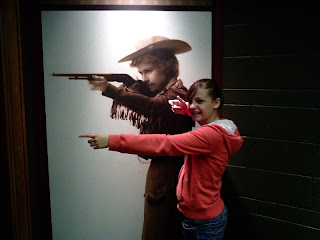
Also in our visit to Darke County, Ohio, we visited the Garst Museum. The museum had an entire section devoted to its hometown hero Annie Oakley. There were all types of artifacts from her life, even down to her chinaware and nightgown. There were guns that she had used and many publicity posters from the Wild West Show. There was also a case of Annie Oakley-inspired memorablilia. I was surprised at all of the books, even modern books, that featured Annie. It amazes me how writers can find so much to write about with these historical figures and when that wasn’t enough, they could bring that character into modern times and create all new adventures.
Monday, August 10, 2009
Homesteading in Ohio
 Also at the Shawnee Nature Center is a log cabin, much like what would have been here in the late 1700’s and early 1800’s. See yesterday's post for a picture I took from the wetlands to show what kind of work the homesteaders had in front of them.
Also at the Shawnee Nature Center is a log cabin, much like what would have been here in the late 1700’s and early 1800’s. See yesterday's post for a picture I took from the wetlands to show what kind of work the homesteaders had in front of them.
Sunday, August 09, 2009
The Wetlands
 Western Ohio actually marks the beginning of the prairies that extend all of the way to the Rockies. This early part of the prairies was a slow transition from the eastern woodlands, so most of the time the land was swampy and very hard to homestead. Pioneers really had to battle the land to cut out fields and homes. One spot at the Shawnee Nature Center gave information about the plants and how because of the wet grounds, the plants had roots that dug very deep into the ground. So, as a homesteader, it would be very difficult to pull up and cut up those deep rooted plants.
Western Ohio actually marks the beginning of the prairies that extend all of the way to the Rockies. This early part of the prairies was a slow transition from the eastern woodlands, so most of the time the land was swampy and very hard to homestead. Pioneers really had to battle the land to cut out fields and homes. One spot at the Shawnee Nature Center gave information about the plants and how because of the wet grounds, the plants had roots that dug very deep into the ground. So, as a homesteader, it would be very difficult to pull up and cut up those deep rooted plants.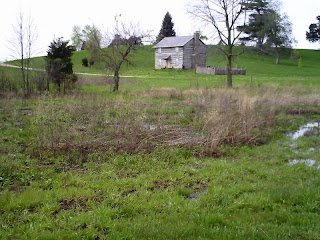 The pictures I’ve included yesterday and today show what this wetland would have looked like. It’s easy to look at this place and envision all of the animals that would have filled this area. I also see the homesteaders trying to tame this land and make it a place to raise a family and make a living in this new land of the free.
The pictures I’ve included yesterday and today show what this wetland would have looked like. It’s easy to look at this place and envision all of the animals that would have filled this area. I also see the homesteaders trying to tame this land and make it a place to raise a family and make a living in this new land of the free.
Saturday, August 08, 2009
Shawnee Prairie Preserve
 As I mentioned in my last post, we visited the site of Prophet Town at the Shawnee Nature Center. According to the Darke County Visitors Bureau, “this 118-acre preserve is the largest Darke County park.” There are “2 miles of trails that showcase the three distinct habitats of this park: woodlands, wetlands, and prairies.”
As I mentioned in my last post, we visited the site of Prophet Town at the Shawnee Nature Center. According to the Darke County Visitors Bureau, “this 118-acre preserve is the largest Darke County park.” There are “2 miles of trails that showcase the three distinct habitats of this park: woodlands, wetlands, and prairies.”  This park also has a Nature Center where Kaleb and Malarie were able to see real stuffed animals that are/were part of the western Ohio habitat. I took a picture of the badger because I’ve never seen a badger in real life and I’ve heard how mean they are. Just the claws on the thing would be enough for me to stay away.
This park also has a Nature Center where Kaleb and Malarie were able to see real stuffed animals that are/were part of the western Ohio habitat. I took a picture of the badger because I’ve never seen a badger in real life and I’ve heard how mean they are. Just the claws on the thing would be enough for me to stay away.  Also, Kaleb gave his best beaver imitation. There were also microscopes where the kids could look at bugs and other specimen from the area. I even took a look at a spider and a honeycomb. There was another spot where you could touch and examine bones, skulls, and antlers. It took some work to convince Kaleb to hold this skull for a picture.
Also, Kaleb gave his best beaver imitation. There were also microscopes where the kids could look at bugs and other specimen from the area. I even took a look at a spider and a honeycomb. There was another spot where you could touch and examine bones, skulls, and antlers. It took some work to convince Kaleb to hold this skull for a picture.
Friday, August 07, 2009
Shawnee Prophet's Town

Tecumseh and his brother established this town just outside of Greene Ville as a place of unity for the tribes worried about the white settlers. This town existed from 1805 to 1808. This spot is now a part of the Shawnee Nature Center. Eventually Tecumseh and Tenskwatawa were asked to move Prophet Town to a place in Indiana. They moved, but the town was burned during the Battle of Tippacanoe.
Again, I rely on Wikipedia for information to share:
Because his father died before he was born and because his mother left his family shortly after, Lalawethika grew up without parents. Lalawethika was then at the mercy of his siblings to teach him the Shawnee ways. Because he was not close with his older sister or older brother, he never learned how to successfully hunt or to be a good warrior, which are essential roles for a Shawnee man. He accidentally lost an eye in a hunting accident. His poor looks and braggart personality also did not win him many friends. As a result, Lalawethika grew up to be the laughing-stock of his community and he turned to alcohol.
Based on Lalawethika's development, it seemed that Lalawethika would never make a contribution to his tribe. However, that changed when Lalawethika was put in trance by the Master of Life. In May 1805, he experienced the first of several visions. He had a taste for whiskey, and in one of his alcoholic stupors he had a vision. After he awoke he began preaching and became a religious leader, and taught that the white Americans were children of the Great Serpent, the source of evil in the world. He also conducted witch hunts against Christian Indians. He forbade his people to use European foods, clothing, manufactured goods and alcohol. He changed his name to Tenskwatawa (The Open Door or One With Open Mouth). In 1808 Tenskwatawa and Tecumseh moved their followers to a new village called Prophetstown (Tippecanoe), near the present-day town of Battle Ground, near the juncture of the Wabash and Tippecanoe rivers in Indiana.
Thursday, August 06, 2009
Tecumseh Point
 Across Mud Creek from Greene Ville Fort, Tecumseh burnt fires in protest to The Treaty of Greene Ville. Tecumseh had fought in the Battle of Fallen Timbers but refused to participate in the signing of the treaty.
Across Mud Creek from Greene Ville Fort, Tecumseh burnt fires in protest to The Treaty of Greene Ville. Tecumseh had fought in the Battle of Fallen Timbers but refused to participate in the signing of the treaty.I pulled the following from Wikipedia so you could learn a little more about Tecumseh:
Tecumseh (Tekoomsē: "Shooting Star" or "Crouching Panther") is believed to have been born on March 9, 1768, just outside the current town of Chillicothe, Ohio. While some historians have located his place of birth at villages further west, modern historians believe this is unlikely as these villages were not yet in existence. His father was Pucksinwah, a minor Shawnee war chief of the Kispoko ("Dancing Tail" or "Panther") branch of the tribe. His mother was named Methoataske and belonged to the Pekowi branch of the tribe and was Pucksinwah second wife. Shawnee lineage was recorded paternally, making Tecumseh a Kispoko. Their tribe was living somewhere near modern Tuscaloosa, Alabama at the time of his parents marriage, having been in that region among the Creek tribe since being driven from homes by the Iroqouis during the Beaver Wars.
About 1759 the Pekowi branch of the tribe decided to move northward into the Ohio Country. Not wanting to force his wife to choose between him or her family, Pucksinwah decided to travel north with her. The Pekowi founded the settlement of Chillicothe where Tecumseh was likely born. Not long after his birth, the family moved again to the village of Scioto. Tecumseh's father took part in French and Indian War during the 1760s, and later in Lord Dunmore’s War; he was killed at the Battle of Point Pleasant in 1774.
At least five times between 1774 and 1782, Tecumseh's village was attacked by colonials and later American armies as the Shawnee allied with the British during the American Revolutionary War. Following his father's death, his family moved back to Chief Blackfish's nearby village of Chillicothe. The town was destroyed in 1779 by Kentucky militia in reprisal for Blackfish's attack on Boonesburough. His family fled, and moved to another nearby Kispoko village, but their new home was destroyed the following year by forces under the command of George Rogers Clark. The family moved a third time to the village of Sanding Stone. That village was attacked by Clark in November of 1782, causing them to move again to a new settlement near modern Bellefontaine, Ohio.
Violence continued unabated on the American frontier after the American Revolution as the Northwest Indian War. A large tribal confederacy, known as the Wabash Confederacy that included all the major tribes of the Ohio and Illinois country, joined together to repel the American settlers from the region. As the war between the confederacy and the Americans grew, Tecumseh became a warrior and took an active part fighting along with his older brother Cheeseekua. Tecumseh took part in several battles, including the 1794 Fallen Timbers, which ended the war in favor of the Americans.
Wednesday, August 05, 2009
Fort Green Ville's Alter of Peace
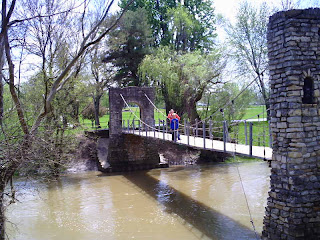
In the city park of Greenville, Ohio we crossed a swinging bridge and hiked a short trail to a hillside where the Alter of Peace stood. This place was the site of where General Wayne kept a torch burning to symbolize peace as the Native Americans and U.S. officials came to terms on the treaty.  (Sorry, I don't know how to turn this picture. If you know, please leave me a comment.)
(Sorry, I don't know how to turn this picture. If you know, please leave me a comment.)
 (Sorry, I don't know how to turn this picture. If you know, please leave me a comment.)
(Sorry, I don't know how to turn this picture. If you know, please leave me a comment.)Tuesday, August 04, 2009
Painting - "The Signing of The Treaty of Greene Ville"

This painting hangs in the Garst Museum in Greenville, Ohio just above the fire place in the Garst House Parlor. The following information comes from the free pamphlet Guide to the Painting “The Signing of The Treaty of Greene Ville” by Howard Chandler Christy prepared by the Department of History Ohio State Archaeological and Historical Society, published by The Darke County Historical Society, reprinted January, 2007.
Howard Chandler Christy’s interest in art began early in his youth. While a young boy he displayed a native talent for drawing. At the age of 20 he went east to make illustrating his livelihood. He contributed to various periodicals, including Scribner’s Magazine, Harper’s Magazine, Collier’s Weekly, Cosmopolitan, and Hearst’s magazines.
About 1920, he turned from illustrating to portrait painting. His list of portraits is a list of many of the noted men of the twentieth century. Presidents, Cabinet officers, Congressmen, industrialists, and a large number of other well-known figures.
The artist established himself as a painter of historic scenes when he produced the large painting, “The Signing of the Constitution.” This historic painting was commissioned by Congress in 1939, and hangs in the national Capital in Washington.
The General Assembly of the State of Ohio authorized the Ohio State Archaeological and Historical Society to secure a painting of the Signing of the Treaty of Greene Ville in January 1945; instructing that Howard Chandler Christy or some other eminent Ohio artist should be commissioned. Mr. Christy was immediately chosen to paint the picture. The necessary historical research for the scene to be portrayed was provided by the historians of the State Historical Society. The picture was completed in July. After its unveiling at Greenville on August 3, it was to be hung permanently in the state Capital at Columbus.
This is me again. The last sentence makes it sound like the real painting isn’t hanging at the museum, but it sure looked real to me. I guess it could be a reprint, but the texture seemed to be real. I wish I had read the information while I was there, so I could have asked. Oh, well, live and learn.
Howard Chandler Christy’s interest in art began early in his youth. While a young boy he displayed a native talent for drawing. At the age of 20 he went east to make illustrating his livelihood. He contributed to various periodicals, including Scribner’s Magazine, Harper’s Magazine, Collier’s Weekly, Cosmopolitan, and Hearst’s magazines.
About 1920, he turned from illustrating to portrait painting. His list of portraits is a list of many of the noted men of the twentieth century. Presidents, Cabinet officers, Congressmen, industrialists, and a large number of other well-known figures.
The artist established himself as a painter of historic scenes when he produced the large painting, “The Signing of the Constitution.” This historic painting was commissioned by Congress in 1939, and hangs in the national Capital in Washington.
The General Assembly of the State of Ohio authorized the Ohio State Archaeological and Historical Society to secure a painting of the Signing of the Treaty of Greene Ville in January 1945; instructing that Howard Chandler Christy or some other eminent Ohio artist should be commissioned. Mr. Christy was immediately chosen to paint the picture. The necessary historical research for the scene to be portrayed was provided by the historians of the State Historical Society. The picture was completed in July. After its unveiling at Greenville on August 3, it was to be hung permanently in the state Capital at Columbus.
This is me again. The last sentence makes it sound like the real painting isn’t hanging at the museum, but it sure looked real to me. I guess it could be a reprint, but the texture seemed to be real. I wish I had read the information while I was there, so I could have asked. Oh, well, live and learn.
Monday, August 03, 2009
The Treaty of GreeneVille
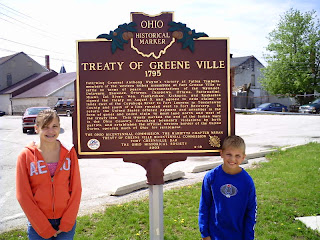
The following two paragraphs are taken from the Visitor’s Bureau booklet; it can also be found on their website:
In August of 1794 , the Legion of the United States, under the command of General Wayne engaged the Indians in northern Ohio at the “Battle of Fallen Timbers.” This decisive battle brought an end to some of the hostilities, and treaty negotiations soon began.
In this monumental fort, the famous Treaty of GreeneVille (also named the Wyandot Peace and Friendship Treaty) was signed by Wayne and chiefs fgrom the Woodland Indian tribes on Auguest 3, 1795. This treaty opened the Northwest territory to white settlers.
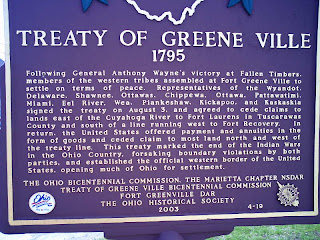 There were other historical figures present at the signing of the Treaty of GreeneVille. William Henry Harrison, who would one day be elected president of the United States, was a lieutenant and served as aide de camp to Wayne. William Clark was a lieutenant of infantry. Meriwether Lewis was a new enlisted soldier in the spring of 1795 and reported directly to Fort Greene Ville. Lewis and Clark fought in the same division at the Battle of Fallen Timbers and will be remembered forever because of their expedition into the Pacific Northwest. On the Native American side, there were also notable historic figures. Little Turtle (Michikinikwa) was a chief of the Miami tribe. He was the main war captain of the Indian forces in the early uprisings against the settlers, but eventually called for tribes to make peace with the whites. When the tribes fought against Wayne’s forces, he handed over leadership to Blue Jacket. According to a pamphlet picked up at the Garst Museum, as Little Turtle “signed the Treaty of Greene Ville he declared, ‘I am the last to sign it, and I will be the last to break it.’” Blue Jacket was the leader of the Indian forces at the Battle of Fallen Timbers. He was “a strong ally of the British from whom, it is said, he held the commission and half pay of a brigadier general.”
There were other historical figures present at the signing of the Treaty of GreeneVille. William Henry Harrison, who would one day be elected president of the United States, was a lieutenant and served as aide de camp to Wayne. William Clark was a lieutenant of infantry. Meriwether Lewis was a new enlisted soldier in the spring of 1795 and reported directly to Fort Greene Ville. Lewis and Clark fought in the same division at the Battle of Fallen Timbers and will be remembered forever because of their expedition into the Pacific Northwest. On the Native American side, there were also notable historic figures. Little Turtle (Michikinikwa) was a chief of the Miami tribe. He was the main war captain of the Indian forces in the early uprisings against the settlers, but eventually called for tribes to make peace with the whites. When the tribes fought against Wayne’s forces, he handed over leadership to Blue Jacket. According to a pamphlet picked up at the Garst Museum, as Little Turtle “signed the Treaty of Greene Ville he declared, ‘I am the last to sign it, and I will be the last to break it.’” Blue Jacket was the leader of the Indian forces at the Battle of Fallen Timbers. He was “a strong ally of the British from whom, it is said, he held the commission and half pay of a brigadier general.”
In August of 1794 , the Legion of the United States, under the command of General Wayne engaged the Indians in northern Ohio at the “Battle of Fallen Timbers.” This decisive battle brought an end to some of the hostilities, and treaty negotiations soon began.
In this monumental fort, the famous Treaty of GreeneVille (also named the Wyandot Peace and Friendship Treaty) was signed by Wayne and chiefs fgrom the Woodland Indian tribes on Auguest 3, 1795. This treaty opened the Northwest territory to white settlers.
 There were other historical figures present at the signing of the Treaty of GreeneVille. William Henry Harrison, who would one day be elected president of the United States, was a lieutenant and served as aide de camp to Wayne. William Clark was a lieutenant of infantry. Meriwether Lewis was a new enlisted soldier in the spring of 1795 and reported directly to Fort Greene Ville. Lewis and Clark fought in the same division at the Battle of Fallen Timbers and will be remembered forever because of their expedition into the Pacific Northwest. On the Native American side, there were also notable historic figures. Little Turtle (Michikinikwa) was a chief of the Miami tribe. He was the main war captain of the Indian forces in the early uprisings against the settlers, but eventually called for tribes to make peace with the whites. When the tribes fought against Wayne’s forces, he handed over leadership to Blue Jacket. According to a pamphlet picked up at the Garst Museum, as Little Turtle “signed the Treaty of Greene Ville he declared, ‘I am the last to sign it, and I will be the last to break it.’” Blue Jacket was the leader of the Indian forces at the Battle of Fallen Timbers. He was “a strong ally of the British from whom, it is said, he held the commission and half pay of a brigadier general.”
There were other historical figures present at the signing of the Treaty of GreeneVille. William Henry Harrison, who would one day be elected president of the United States, was a lieutenant and served as aide de camp to Wayne. William Clark was a lieutenant of infantry. Meriwether Lewis was a new enlisted soldier in the spring of 1795 and reported directly to Fort Greene Ville. Lewis and Clark fought in the same division at the Battle of Fallen Timbers and will be remembered forever because of their expedition into the Pacific Northwest. On the Native American side, there were also notable historic figures. Little Turtle (Michikinikwa) was a chief of the Miami tribe. He was the main war captain of the Indian forces in the early uprisings against the settlers, but eventually called for tribes to make peace with the whites. When the tribes fought against Wayne’s forces, he handed over leadership to Blue Jacket. According to a pamphlet picked up at the Garst Museum, as Little Turtle “signed the Treaty of Greene Ville he declared, ‘I am the last to sign it, and I will be the last to break it.’” Blue Jacket was the leader of the Indian forces at the Battle of Fallen Timbers. He was “a strong ally of the British from whom, it is said, he held the commission and half pay of a brigadier general.” Sunday, August 02, 2009
Fort Greene Ville

After leaving the sight of Fort Jefferson, we headed north toward the sight of Fort Greene Ville. We found the sign at the edge of downtown Greenville, right in front of the municiple building. If I understand correctly, that point was a corner of Fort Greene Ville and the fort followed the banks of the Mudd Creek past where the creek forks with Greenville Creek. The fort was built by General Anthony Wayne. It was “the largest log fortified structure ever built, encompassing 55+ acres of land enclosed by wooden stockades and surrounded by 8 blockhouses. The fort stood for six years and was partially rebuilt during the War of 1812” (http://www.discoverourlegends.com/).
The reason the fort was built was because there were more and more whites coming into western Ohio in the 1700’s. The Native American tribes that were already there began to realize that their ways of life were in danger and began to clash with the settlers. President Washington sent General Wayne to handle the uprisings. Wayne built the Greene Ville Fort in 1793.
The reason the fort was built was because there were more and more whites coming into western Ohio in the 1700’s. The Native American tribes that were already there began to realize that their ways of life were in danger and began to clash with the settlers. President Washington sent General Wayne to handle the uprisings. Wayne built the Greene Ville Fort in 1793.
Saturday, August 01, 2009
Fort Jefferson
One of the great things about life is the unexpected treasures God lays before us. When we get up in the morning, we can have the greatest plans prepared and often we follow those exactly as we planned. But when things take a different turn, it often turns into a blessing.
Well, on a Saturday back in the spring my wife and two youngest daughters spent the day shopping with my mother-in-law. Since my oldest daughter and son were with me and all baseball games were rained out (or I should say, “flooded out), we decided to take an historic adventure. We headed to the Levi Coffin House in Fountain City, Indiana only to find that it won’t be open until June. So, we will come back to that one this summer.
We decided to go to the Richmond Museum because they have some really neat exibits. But, we saw the sign for the “Highest Point in Indiana.” We headed out into the country and drove for mile and miles until we came up on the small community of Arba, Ohio. No chance of finding the highest point in Indiana there, so we turned around. There was a sign going that direction that told us to turn again. I have no idea why there wasn’t a sign coming from the other direction. So, once again we went for miles and miles. We could tell we were gradually going uphill all the way, but there were no signs. Hitting the Ohio lines once again, I decided we would follow the line of colonial forts through that part of Ohio. As you may already know, there was a line of colonial forts from Cincinnati to Toledo, which made it easier for the newly formed permanent army of the United States to make the Ohio Territory safe for settlers. Malarie and Kaleb were up for the adventure, so we headed for our first marker. It was almost like we were on a photo scavenger hunt.
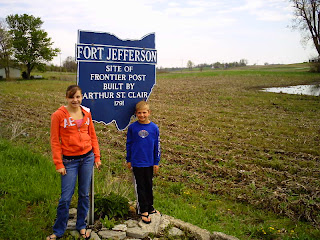 After coming off the country roads and to a main highway, we headed straight for the sight of Fort Jefferson. As you can see from the picture, there was nothing more than a sign, but with a little imagination we could see the fort standing by the marsh lands. This fort was the site of a great Shawnee victory against St. Clair's army. Not until General Anthony Wayne came to "tame" the area did the U.S. forces reclaim this fort.
After coming off the country roads and to a main highway, we headed straight for the sight of Fort Jefferson. As you can see from the picture, there was nothing more than a sign, but with a little imagination we could see the fort standing by the marsh lands. This fort was the site of a great Shawnee victory against St. Clair's army. Not until General Anthony Wayne came to "tame" the area did the U.S. forces reclaim this fort.
Well, on a Saturday back in the spring my wife and two youngest daughters spent the day shopping with my mother-in-law. Since my oldest daughter and son were with me and all baseball games were rained out (or I should say, “flooded out), we decided to take an historic adventure. We headed to the Levi Coffin House in Fountain City, Indiana only to find that it won’t be open until June. So, we will come back to that one this summer.
We decided to go to the Richmond Museum because they have some really neat exibits. But, we saw the sign for the “Highest Point in Indiana.” We headed out into the country and drove for mile and miles until we came up on the small community of Arba, Ohio. No chance of finding the highest point in Indiana there, so we turned around. There was a sign going that direction that told us to turn again. I have no idea why there wasn’t a sign coming from the other direction. So, once again we went for miles and miles. We could tell we were gradually going uphill all the way, but there were no signs. Hitting the Ohio lines once again, I decided we would follow the line of colonial forts through that part of Ohio. As you may already know, there was a line of colonial forts from Cincinnati to Toledo, which made it easier for the newly formed permanent army of the United States to make the Ohio Territory safe for settlers. Malarie and Kaleb were up for the adventure, so we headed for our first marker. It was almost like we were on a photo scavenger hunt.
 After coming off the country roads and to a main highway, we headed straight for the sight of Fort Jefferson. As you can see from the picture, there was nothing more than a sign, but with a little imagination we could see the fort standing by the marsh lands. This fort was the site of a great Shawnee victory against St. Clair's army. Not until General Anthony Wayne came to "tame" the area did the U.S. forces reclaim this fort.
After coming off the country roads and to a main highway, we headed straight for the sight of Fort Jefferson. As you can see from the picture, there was nothing more than a sign, but with a little imagination we could see the fort standing by the marsh lands. This fort was the site of a great Shawnee victory against St. Clair's army. Not until General Anthony Wayne came to "tame" the area did the U.S. forces reclaim this fort.Go here to find more information about Fort Jefferson.
Subscribe to:
Posts (Atom)


